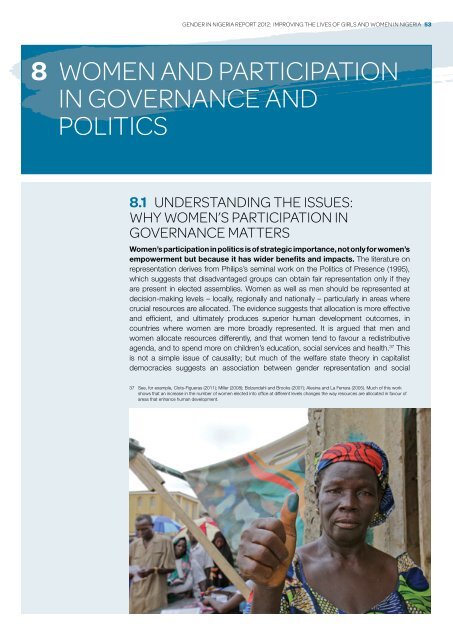Gender in niGeria report 2012 - Economic Commission for Africa
Gender in niGeria report 2012 - Economic Commission for Africa
Gender in niGeria report 2012 - Economic Commission for Africa
Create successful ePaper yourself
Turn your PDF publications into a flip-book with our unique Google optimized e-Paper software.
<strong>Gender</strong> <strong>in</strong> Nigeria Report <strong>2012</strong>: Improv<strong>in</strong>g the Lives of Girls and Women <strong>in</strong> Nigeria 53<br />
8 WOMEN AND PARTICIPATION<br />
IN GOVERNANCE AND<br />
POLITICS<br />
8.1 Understand<strong>in</strong>g the issues:<br />
why women’s participation <strong>in</strong><br />
governance matters<br />
Women’s participation <strong>in</strong> politics is of strategic importance, not only <strong>for</strong> women’s<br />
empowerment but because it has wider benefits and impacts. The literature on<br />
representation derives from Philips’s sem<strong>in</strong>al work on the Politics of Presence (1995),<br />
which suggests that disadvantaged groups can obta<strong>in</strong> fair representation only if they<br />
are present <strong>in</strong> elected assemblies. Women as well as men should be represented at<br />
decision-mak<strong>in</strong>g levels – locally, regionally and nationally – particularly <strong>in</strong> areas where<br />
crucial resources are allocated. The evidence suggests that allocation is more effective<br />
and efficient, and ultimately produces superior human development outcomes, <strong>in</strong><br />
countries where women are more broadly represented. It is argued that men and<br />
women allocate resources differently, and that women tend to favour a redistributive<br />
agenda, and to spend more on children’s education, social services and health. 37 This<br />
is not a simple issue of causality; but much of the welfare state theory <strong>in</strong> capitalist<br />
democracies suggests an association between gender representation and social<br />
37 See, <strong>for</strong> example, Clots-Figueras (2011); Miller (2008); Bolzendahl and Brooks (2007); Ales<strong>in</strong>a and La Ferrara (2005). Much of this work<br />
shows that an <strong>in</strong>crease <strong>in</strong> the number of women elected <strong>in</strong>to office at different levels changes the way resources are allocated <strong>in</strong> favour of<br />
areas that enhance human development.

















